From poi to poke to pineapple, a look at how Hawai`i’s eclectic local cuisine was born.
Modern Hawai`i is young, I realize from my vantage point on the peak of Mauna Kea, the highest point in the state. Without moving, I can see all five of the state’s volcanos, even Maui’s Haleakala, which sits across a blue sea channel. To the east, steam rises in a plume where lava flows into the ocean, adding 42 acres to the island every year.
Like the lava, Hawai`i’s culture and cuisine has grown, layer by layer, over years, expanding as waves of immigrants each brought something new to the islands. These ingredients—beef, rice, spam, pineapples, soy sauce, black pepper, and many others—mingled and fused to create the “local style” dishes that are unmistakably and perplexingly Hawaiian. Why are macaroni salad and white rice paired on the Hawaiian plate lunch? Or pork-stuffed Chinese rice buns a gas station specialty? Why do Portuguese pastries outsell the all-American donut? Finally, Hawaiian pizza—just why?
Digging down through the layers of Hawai`i’s home cooking exposes a chronology of people, plants and politics that together build what today we think of as Hawaiian cuisine.
Pre-1778: The Polynesians
Daniel Anthony and his crew throw a makeshift lunch table over the shallow concave kui boards, where all morning they’ve been heaving basalt lava pestles into a mash of taro root. The food arrives in plastic containers: shredded seaweed salad, flakey imu-baked tuna, kālua pork, fried bananas, and a bag of crackers. Daniel reaches into one of the kui and slaps out a grey-lavender slab of pa’i’ai, the sticky precursor to poi, to add to the lunch spread.
“We eat poi every day,” he says. “Like the ancient Hawaiians.”
Anthony’s small company, Mana Ai, is bringing back the simple, whole foods carried to Hawaii by Polynesian sea voyagers around 300 CE. These first immigrants brought an onslaught of imported foodstuffs, including chickens, pigs, dogs for eating, and the staple “canoe plants”: taro, bananas, breadfruit, sugar cane, and coconuts.

These basic ingredients, flavored with ti leaves or ginger and thick granules of sea salt, gave the ancient Hawaiians a health and vitality that impressed the motley crew of European sailors who arrived with Captain Cook in 1778.
“It’s something that seems so simple, but this is why they were so healthy.” Anthony waves to the taro.
In addition to poi, the Hawaiians mixed taro with coconut and sugar cane into a thick, chewy pudding called kulolo. Taro leaves, lū‘au, gave the classic Hawaiian feast its name. The leaves were wrapped around meat to grill on hot rocks (laulau) or stewed with coconut milk and bits of fish or diced meat (lū‘au ‘ulo) and served, of course, with a calabash of poi. Everything else—the seaweed, the marinated raw fish (poke), even kālua pig smoked with sandalwood over hot rocks—was a condiment to add flavor to poi. Even the earliest Europeans ate a diet dependent on poi, although they brought their own seasonings and sides.
1793: Spanish cowboys settle down
“Smell that,” Lloyd Case says, holding out long, ropey slices of blood-red meat for me to sniff. “That’s the real Hawai`i beef.”
I’m trying hard not to be weirded out by his kitchen. Seven glassy-eyed boar heads stare down at me as Case happily clucks over the marinade, a mixture of garlic, black pepper, sugar, and sea salt. When he was younger, Lloyd cooked for the cowboys who lived and worked around Parker Ranch, at one time the largest individually-owned cattle operation in the United States.
Today we’re making pipi kaula, the sun-dried “beef rope” Hawaiian cowboys once tucked in their shirt pocket for long rides. The first cattle landed at a port nearby in 1793, a gift from Captain George Vancouver to King Kamehameha I. The king put a royal prohibition, kapu, on the small herd and allowed it to grow until the feral one-ton pipi were a destructive danger. In 1831, a Spanish vaquero fled unrest in Mexican-Spanish California, arriving in Hawai`i on a whaling ship. He ended up in service to the king as a cattle herder. Over the next few decades, more vaqueros settled in the area, bringing recipes using black pepper, garlic, onion, hot chilies, and, of course, every part of the cow.
Case throws the partially dried pipi kaula, juicy inside the congealed skin, on a pan. While it cooks he arranges scales of sweet Maui onion on a plate around a pile of chunky Hawaiian salt and adds a hefty dollop of poi. When the beef is done, he layers the salt, poi, and pipi kaula onto an onion slice with a few shakes of chili pepper water and takes a bite.
“That’s a real special flavor. That the original cowboy recipe,” he says triumphantly. He likes it, but he prefers his family’s recipe, which has an Asian flair thanks to the addition of soy sauce, teriyaki, and ginger.
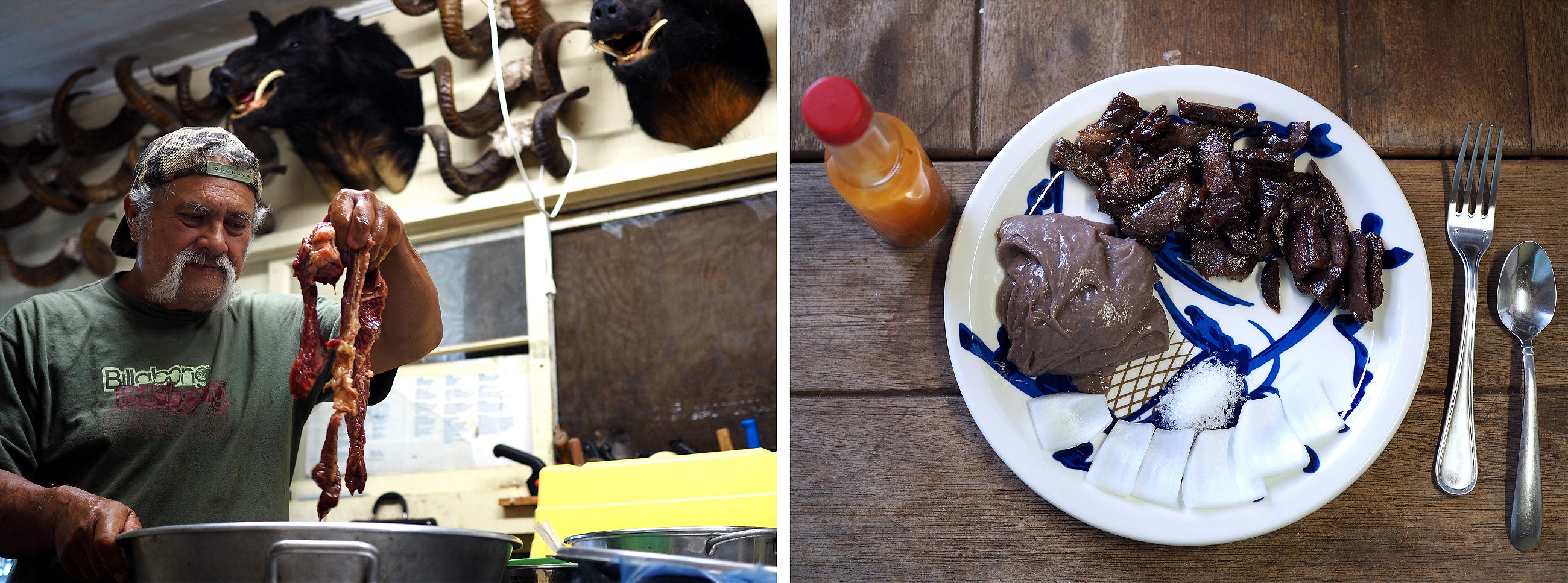
1852: Chinese laborers arrive
I find manapua at a Chevron mini-mart. It’s in a glass case that elsewhere would hold hot dogs, and since it looks just like a jumbo-sized Chinese bao—a steamed rice-flour bun stuffed with pork—I keep saying “mana-pow” instead of “mana-poo-ah.” The clerk gives me a funny look. Tourist.
Manapua means “delicious pork thing” in the Hawaiian language; it is basically a large bao stuffed with char siu, pork cooked in five-spice, soy sauce, rice vinegar, and food coloring to make it sweet, spicy, and rimmed in red. It’s a cheap, on-the-go snack brought by Chinese sugar laborers who began arriving as strikebreakers in 1852, after native Hawaiian workers started walking off the job over low pay and poor working conditions. In the next three decades, the population of Chinese grew from fewer than 400 individuals to more than 18,000.
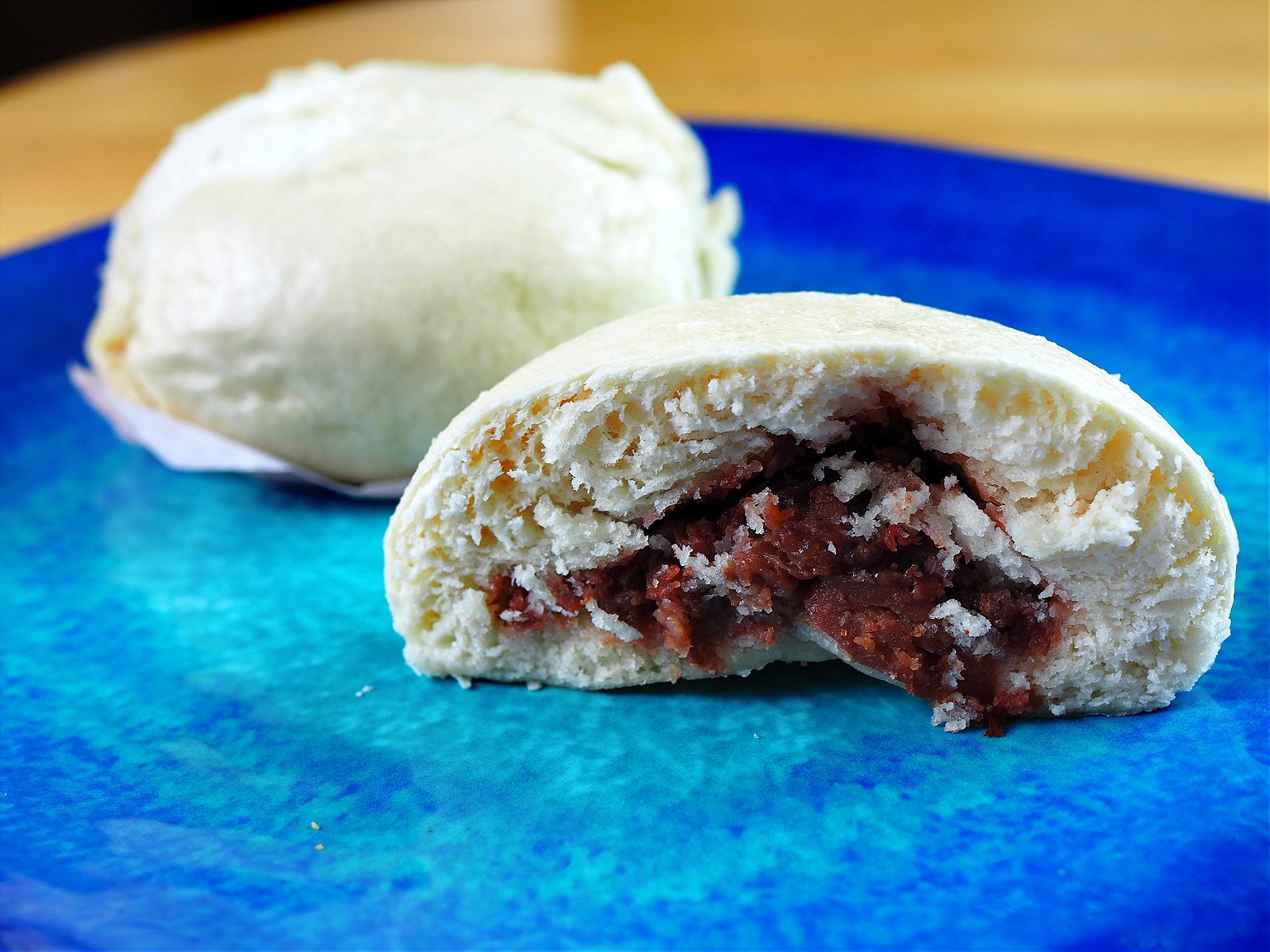
Legend has it that the first strike staged by Chinese laborers was over “poi rations.” Chinese laborers demanded rice, not poi, and they got it. Chinese appetites fueled a local market that became a lucrative export industry as profitable as sugar cane. Many Chinese laborers, on completing their five-year contracts, obtained land leases and filled abandoned taro fields with rice. Today, Hawaiians consume nearly four times more rice than mainland Americans, and the double scoop of rice is a plate lunch fixture.
The Chinese also brought saimin, a Chinese noodle soup in clear broth. Even after the era of Chinese immigrant laborers was over, every subsequent immigrant group adopted saimin and added their own toppings, which is why modern versions can have char siu, Portuguese sausage, Japanese kamaboko (fish cake), Korean kim chee and Spam all in the same bowl.
Chinese immigration slowed and halted in the years before the United States Congress passed the racist 1882 Chinese Exclusion Act, which ended all Chinese labor immigration to the U.S. Hawai’i wasn’t exactly America yet—it would not become a state for nearly 80 years—but European sugar planters nonetheless reacted by recruiting European laborers.
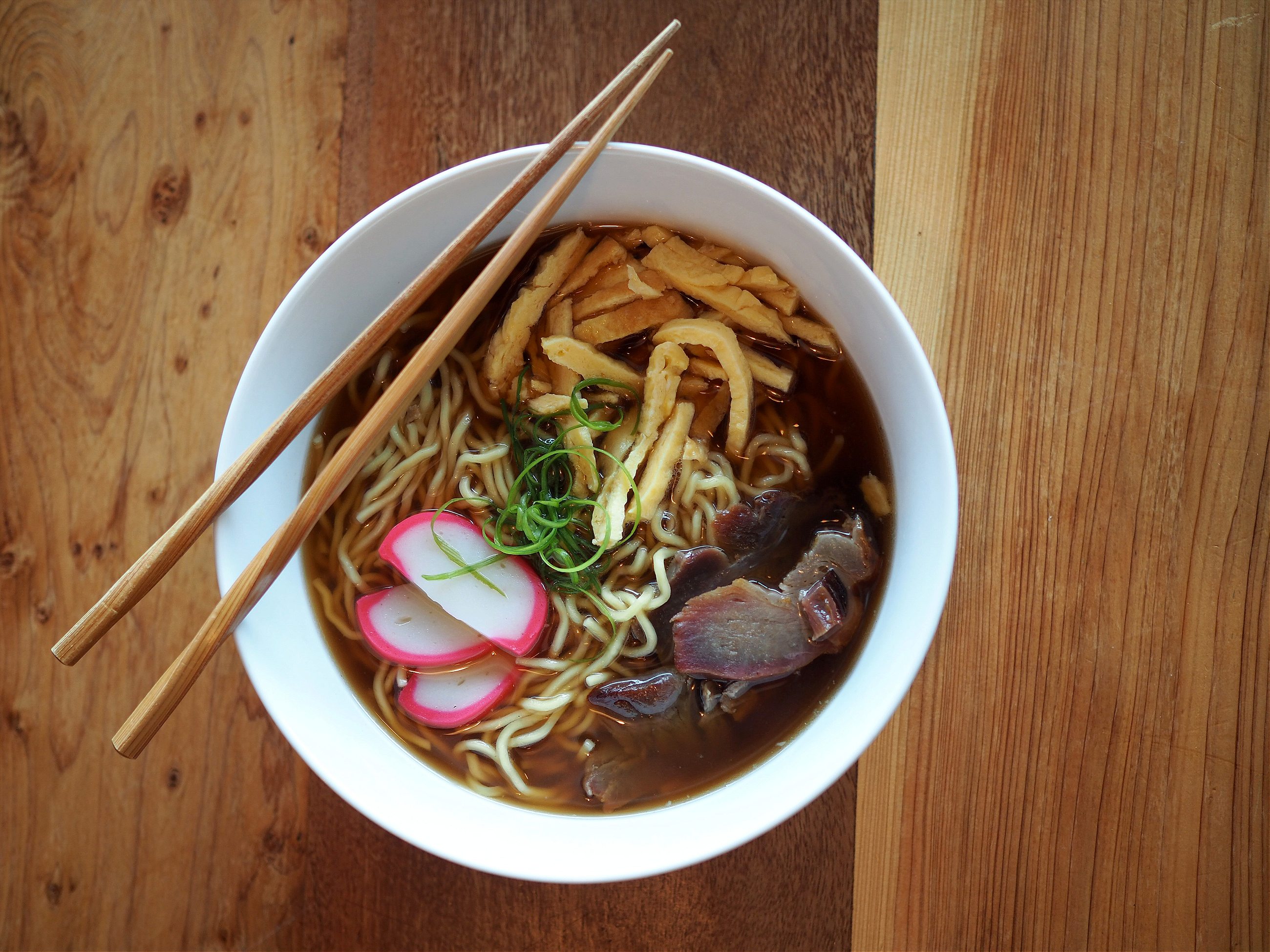
1878: Portuguese farmers put down roots
I pass Tex’s Drive-In on the Hāmākua Coast twice on my way to see Lloyd Case. The sign reads World Famous Malasadas and Ono Kine Food. The third time I pass it, I stop and peer through the glass window, where workers are flipping cubes of dough into oil vats.
Along the drive I’d seen food trucks, coffee shops, and bakeries with signs for malasadas, fluffy square donuts rolled in sugar. The Portuguese from the islands of Madeira and the Azores typically made the treats on Fat Tuesdays before Lent, a day now known in Hawai’i as Malasada Day.

Portuguese sailors plying the fur and whaling trades began passing through Hawai`i early on, but became more common after 1830, when drought and famine hit the Portuguese islands. The sailors acquired salted salmon from Native Americans on the U.S. mainland and ate it as substitute for bacalhau, the salted codfish base of Portuguese recipes. They rarely settled, but when they docked in Hawai`i the sailors bartered salmon for beef, sugar, and coffee. Diced finely with onion and tomato, salmon salad (lomi-lomi) became a staple of Hawai`i’s poor and eventually replaced the traditional poke, raw fish salad, at Hawaiian lū‘au.
In 1878, the first boatload of Portuguese islanders arrived to work the sugar fields. Unlike the Chinese, their contract permitted them to bring wives and children and gave them an acre of farmland. Within 10 years, the miniscule Portuguese community of less than 500 people swelled to 10,000, nearly 10 percent of Hawai`i’s total population.
Portuguese sausage, or linguiça, now replaces bacon at local pancake houses. Sweet and flakey dinner rolls, pao doce, get used for hamburger buns and sliders—you may know it as the “Hawaiian sweet bread” found in deli cases throughout the lower 48. Scanning the menu at Tex’s, I discover that it’s buy one-get-one-free soup day. I order the Portuguese bean soup, thick and meaty and ladled over short-grained white rice—not the long-grain rice planted by the Chinese. The next wave of immigrants, the Japanese, changed Hawai`i’s taste for rice and the economy, again.
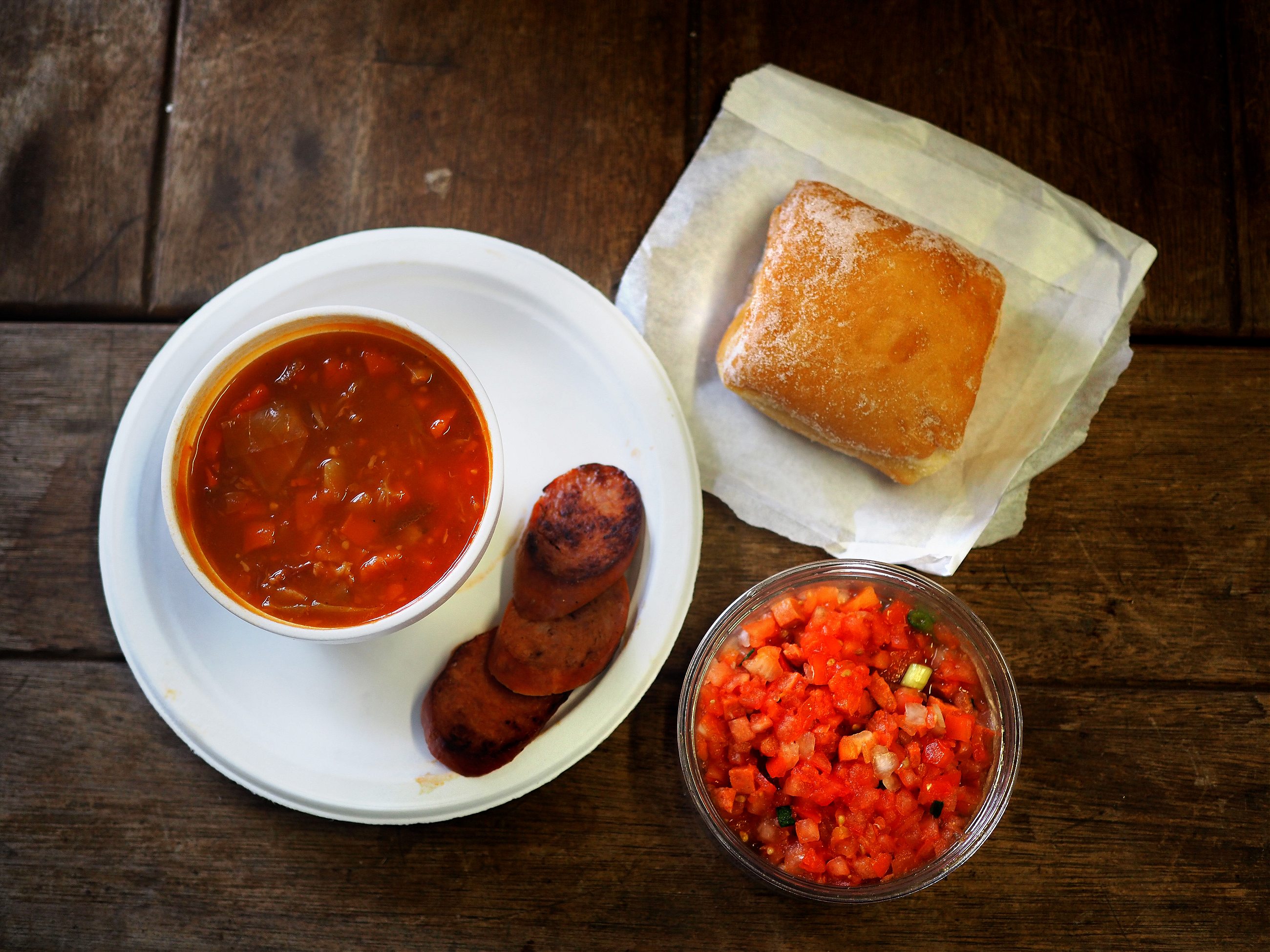
1885: Japan opens its borders
Our order at L&L Hawaiian Barbecue comes in Styrofoam gracelessly arranged on a red plastic tray. My friend looks at it doubtfully.
“Are you sure we’re here for Japanese food?”
“No,” I say. “Japanese-influenced Hawaiian food.”
When Japanese citizens were finally permitted to seek work abroad after nearly three centuries of isolationist politics, they came to Hawai`i at an unprecedented rate. From only 116 persons in 1884, by 1920 over 100,000 Japanese lived, shopped, and ate on the islands. They’re still one of the biggest ethnic groups.
Japanese food preferences were so influential that their dislike of the long-grain rice grown by local Chinese farmers ended the Hawaiian rice industry and prompted Hawai`i to import short-grain rice from California. The problem with long-grain rice was that it didn’t clump easily for pressing into o-musubi, rectangular bars of rice, meat, or pickles wrapped in green-black nori or laver that Japanese field hands could pocket for a snack. After World War II, the Spam musubi on our Styrofoam plate, with its greasy pink slab, became a favorite grab-n-go lunch item.
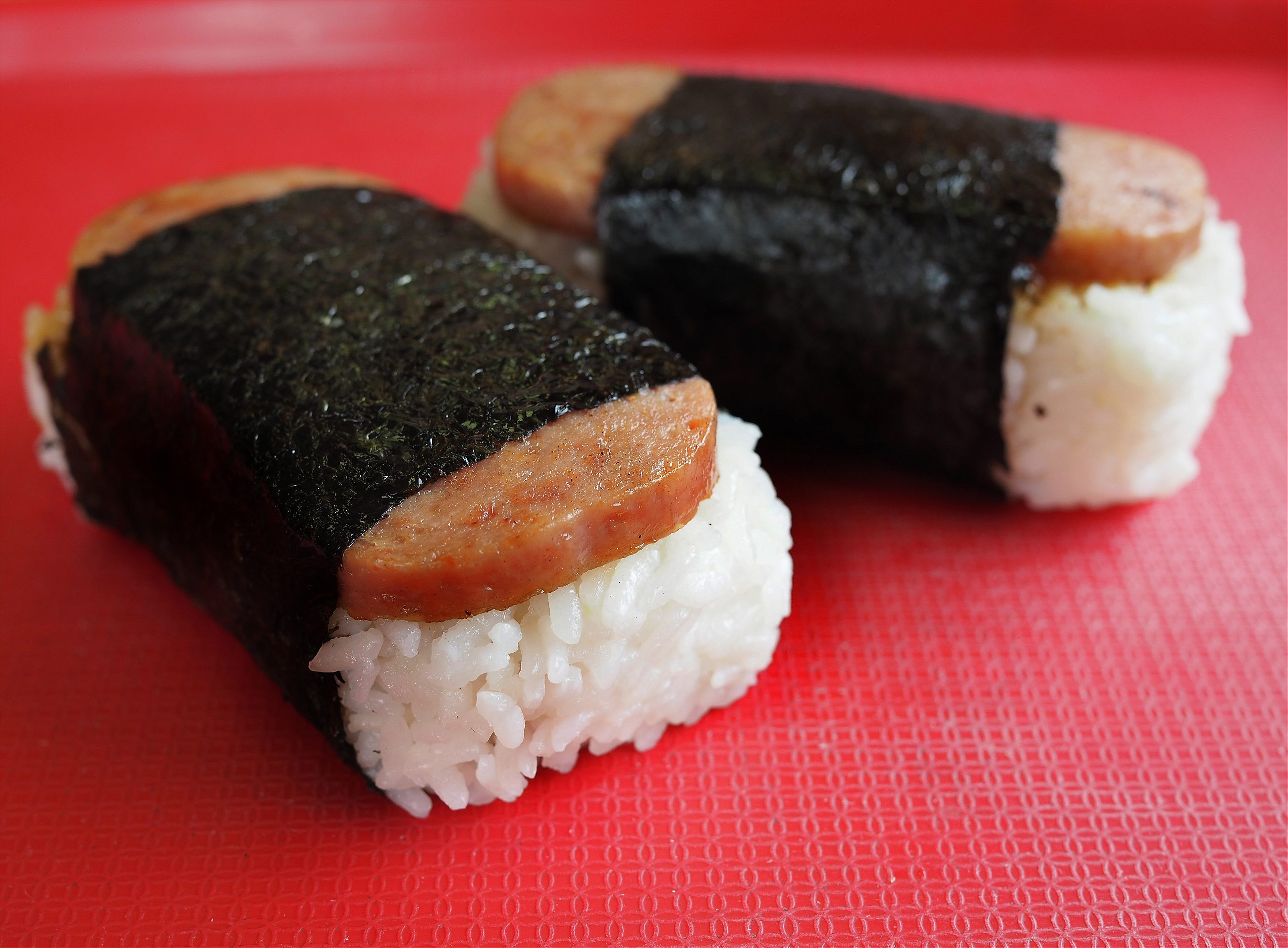
Laborers also packed rice, with one or two entrées and a few sides, in the segmented bento box that evolved into the iconic Hawaiian plate lunch. Ours features a Japanese-influenced entrée, Chicken Katsu, along with the requisite double scoop of short-grain rice and shiny lump of macaroni salad. The chicken is fried in a light tempura batter, and sliced into boneless strips, and comes with a gingery soy sauce.
After lunch, we wander over to Hilo’s Ono Kine Ice Shave, across the street from the farmer’s market. Around 1920, ice became common enough for the Japanese to introduce a centuries-old dessert, kaki-gori, or “shave ice.” It’s better than the pebbly American snow cone because the ice is scraped so finely that the fluffy head absorbs all the sweet rainbow of syrups.
Japanese immigration began dwindling after 1900, when Hawai`i became a territory of the United States and the work contracts keeping immigrants tied to plantations became illegal under the U.S. Constitution. Many Japanese went on strike or formed unions, and sugar planters hunted again for new people to bring to the islands.
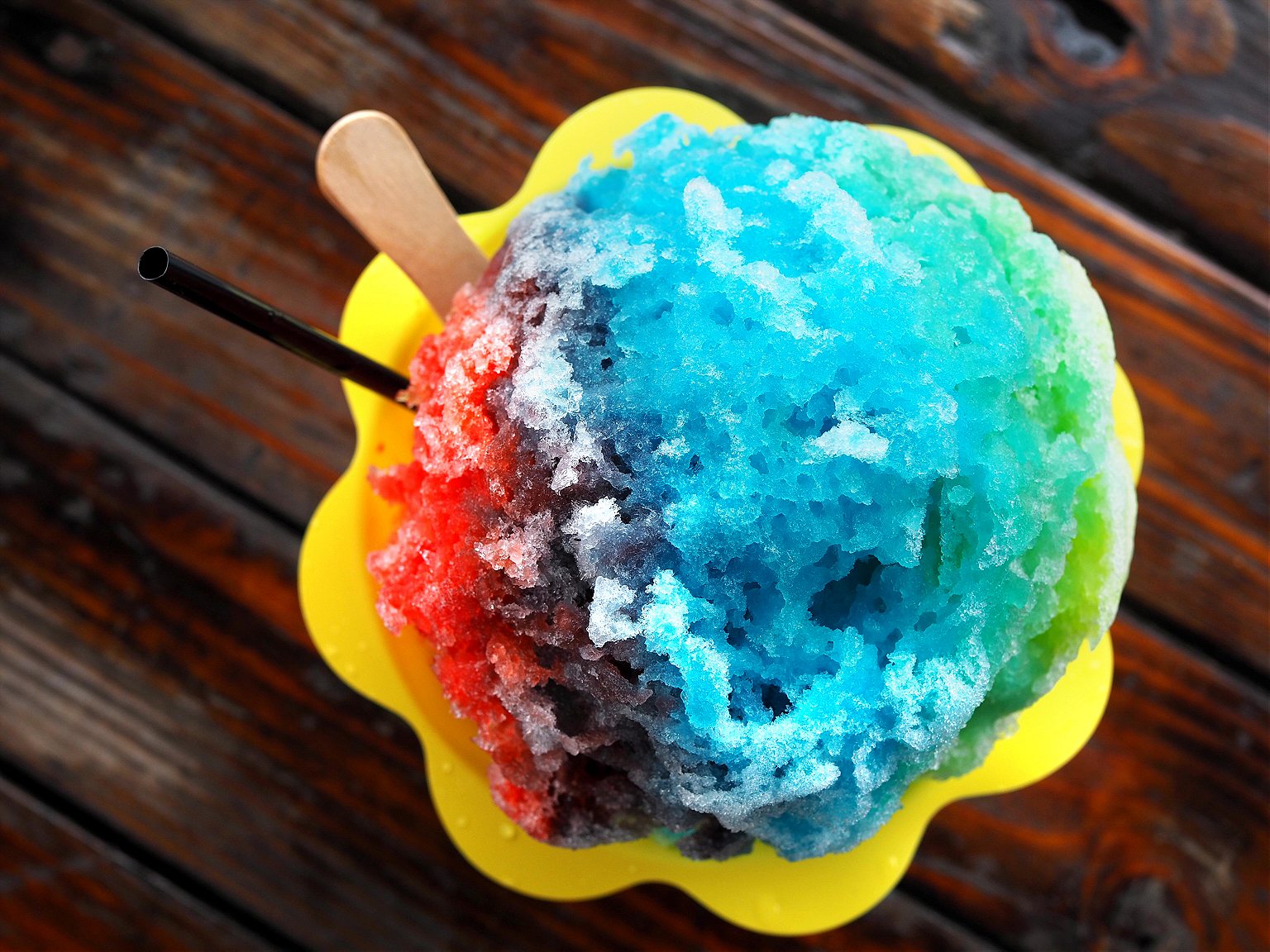
1900: Puerto Rico’s sugar industry takes a hit
I scan Highway 11 for Benlynne Astel’s big white sign covered with hand-drawn letters. She’s a third-generation Puerto Rican-Hawaiian who sells her grandmother’s recipes out of the back of a silver van, where food licenses dangle from the cloth ceiling.
Puerto Ricans were an obvious choice to break the Japanese sugar strikes; Puerto Rico was a newly acquired U.S. territory, so restrictions placed by Congress on hiring foreign workers didn’t apply. Records of Puerto Rican arrivals weren’t even required, so it’s only an estimate that 5,000 of the new arrivals took over the sugar fields in 1901. To top it off, Puerto Rico’s thriving cane fields were demolished by two hurricanes in 1899. The market was free of competition and Puerto Rico’s experienced cane workers were in need of jobs.
While the period of Puerto Rican immigration was relatively short, local Hawaiians have developed a bit of a cult following for the nameless hole-in-the-walls, food trucks, and roving table-and-tents that serve up Puerto Rican fare along the highways. There’s already a short queue when I find Astel’s van.
“It’s a good thing you placed an order,” her son says, passing out brown-paper packages of gandule rice, colored with annatto and sprinkled with pork and pigeon peas, and panadejas, deep-fried pork pies in a flakey pastry. They’ve already run out of the local favorite, the tamale-like pasteles (pronounced pah-teles), made with ground green banana masa, spicy pork, and cilantro and steamed, in a Hawaiian twist, inside ti leaves.
On the way home, we stop and pick up some apple bananas, the small ones with a delightfully tangy flavor. There are two varieties of apple banana in Hawai`i, one from Puerto Rico called manzano. In the new century, exotic tropical fruits played a bigger role in Hawai`i’s history, especially pineapple.
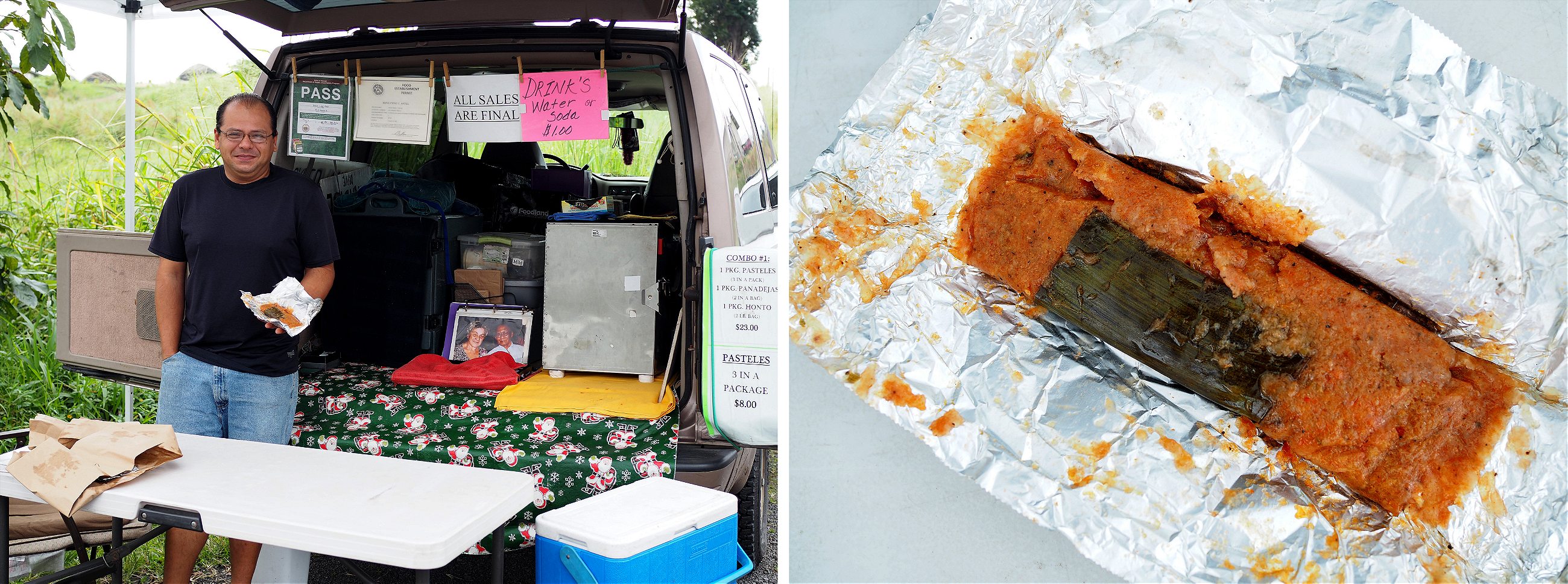
1903: Korean strike breakers are recruited
I juggle jars of kim chee in KTA supermarket’s produce aisle. I look first at the plain cabbage version, called won bok, then at the daikon radish, cucumber, and turnip version. Maybe, I think, I should get the Kohala brand, since I’ve heard it’s the oldest commercial kim chee company in the islands.
Local-style kim chee has been sold at mainstream grocery stores since at least 1939. Unlike the authentic soggy, heavily fermented version, in Hawai`i, kim chee is eaten crisp and spicy, freshly pickled in hot chili pepper brine. It’s a salty, tangy, and spicy vegetable condiment I think I could eat on everything, which is probably why in Hawai`i they do. Kim chee pizza is authentically Hawaiian; pizza with pineapple chunks is not.
Pineapple did play a role in bringing the first Korean immigrants to Hawaii in 1903. The first pineapple plantations were established at the end of the 1890s, and when the Japanese started striking there weren’t enough laborers for both sugar and pineapple fields. In desperation, the sugar planters sent a recruiter to Korea in 1902. He made agreements with the Christian missionaries there to bring laborers illegally into Hawai`i, violating contract immigration laws. Between 1903 and 1905, over 7,000 Korean Christians became illegal immigrants. By the time legal immigrants arrived after the Korean War, their food was already absorbed into the Hawaiian melting pot.
Kim chee is now ubiquitous, added to saimin soup or tucked inside musubi, or spread over kālua pork sandwiches. It’s also often served as a side to Korean-style barbecues like bulgogi or kalbi. I’m slightly disappointed when our kalbi plate lunch at the Hawaiian Style Café in Waimea doesn’t include kim chee. The kalbi is thin cuts of short rib, seasoned in a sweet marinade, darkened with soy sauce and then grilled over an open flame. It comes with macaroni salad and rice, of course.
Sugar and pineapple planters were happy with Korean workers, but after just two years Japan annexed Korea and shut down all emigration, even the illegal sort. Recruiters went to one last country looking for workers.

1907: A U.S. territory provides an immigration loophole
There are more Filipino desserts at the Saturday Hilo Farmer’s Market than I know how to consume. I greedily collect a container of lavender hued coconut-milk-and-purple-sweet-potato pudding with chunks of taro and tapioca pearls (binignit) from between the pyramids of papayas before finding gummy sticks of suman, glutinous rice and sugar steamed in banana leaves, wedged next to a pile of greens. With the muffins and cakes I find ensaymada, a buttery, brioche-like bread slathered in cheese and sugar. I hear the Filipino twang in the womens’ voices as they accept my cash.
At a take-away table spread with plastic clamshells of vinegary stews like pork blood (diniguan) vegetable in tomato sauce (pinakbet) and pork and pea (pork guisante), I stop and chat with the shy chef, Velma Marzan. Like many of the ladies at the farmer’s market, she’s a first-generation immigrant, one of the 3,000 or so Filipinos who arrive in Hawai`i every year.

The Filipinos were first brought to Hawai`i in 1907 as strike breakers. Since at that time the Philippines was a U.S. territory, plantations could avoid immigration hassles by recruiting Filipino workers. The first 150 arrived that year. By 1935, Filipinos comprised 70 percent of the labor force, and as of 2010, they’re the largest ethnic group in Hawai`i.
Maybe because the Philippines itself was already a cultural melting pot, Filipino cuisine quickly became a staple. You can find ensaymada in bakeries and binignit on supermarket shelves. Adobo, a messy, saucy stew made from either pork or chicken boiled in vinegar and soy sauce, can be found on the Hawaiian lunch plate in a trifecta with rice and mac salad, a mysterious combination that can only be explained by the last major cultural influence on Hawaii: becoming part of America.
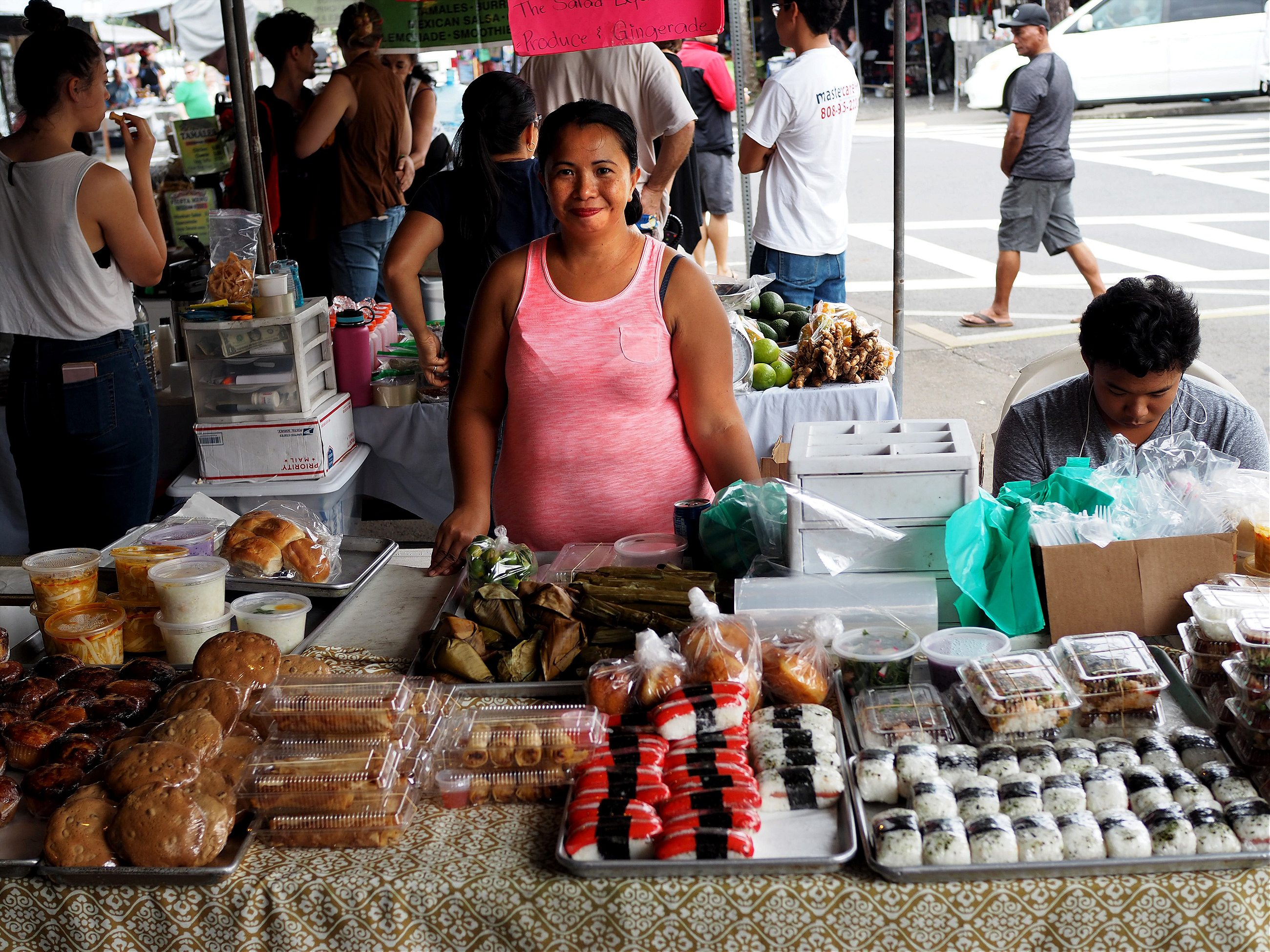
Post-1941: Mainlanders head to the islands
“How come nothing on your list so far includes pineapple?” my friend asks as we head to our final food destination. “Except for the shave ice, but that was probably artificial.”
“We’ve been brainwashed by American marketing,” I say.
Americans began arriving to Hawai`i in droves after the Pearl Harbor bombing: first the influx of 40,000 military servicemen, then up to a million tourists a year by the 1960s after Hawai`i became a state.
It’s possible missionaries brought the recipe for the overcooked, swollen macaroni noodles served cold and slathered in mayonnaise, since “Deli Mac” was a popular food item in New England the 1920s. It’s also possible military cooks introduced it during the war, along with Spam, the salty pink lunchmeat still loved by Hawaiians. G.I.s on reprieve preferred to frequent hamburger joints and drive-ins, inspiring the 1940s invention of loco moco, a hearty mess of sunny-side up eggs over beef patties and rice slathered in gravy.
Pineapple companies capitalized on America’s post-war infatuation with Hawaii. Several 1950s cookbooks like A Hawaiian Lu’au taught mainlanders how to make “Hawaiian” creations never before served on the islands, like pineapple baked beans or pineapple upside down cake. Canadians invented Hawaiian pizza around this time. Eventually even Hawaiian cooks added pineapple to dishes like Spam-fried rice, partly to placate expectant tourists, and partly for the delicious freshness pineapple adds to starch-heavy, pork-heavy, fried Hawaiian comfort food.
In 1992, 12 Hawaiian chefs officially introduced the idea of “Hawaii Regional Cuisine,” local-style food using fresh ingredients that grow on the islands. The chefs formed a non-profit, and trademarked their new designation. So for our final food destination, I lead us to Sweet Cane Café in Hilo, a vegetarian joint run by a family that also owns the farm that provides all of their produce. I order a taro burger and a sugar cane shake. The burger is dense and meaty, with a bit of stickiness I recognize from the pa’i’ai I ate with Daniel Anthony. It tastes like something old transformed into something new. That, I realize, is the taste of Hawaii.